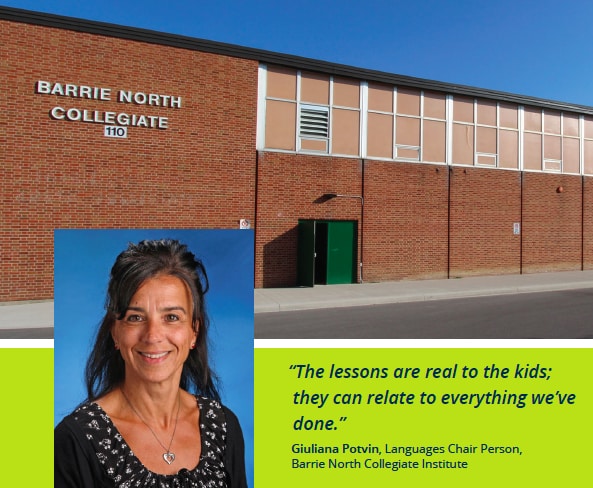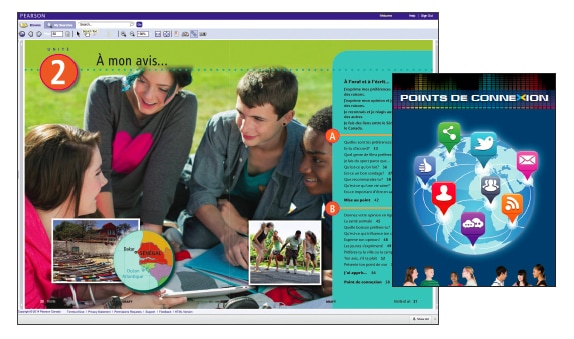Points de Connexion CASE STUDY
Educators immediately impressed with Points de Connexion French program

Background
In September 2014, the Ontario Ministry of Education announced a significant overhaul to French curriculum in the province.
Goals
The new curriculum is focused on students communicating and interacting with growing confidence in French while developing their knowledge and skills in speaking, listening, reading and writing, and increasing their intercultural awareness.
Implementation
Unionville High School and Barrie North Secondary School implemented Pearson’s Points de Connexion program. As a result, teachers can meet new curriculum requirements, embed culture in lessons and create more opportunities for students to improve their speaking and listening skills.
Peter Lansing’s Grade 9 French classroom is abuzz as students move about the room discussing their thoughts on the latest movies, culture in Vietnam or the latest social media trends – all in French of course. Verb forms might not be perfect and mispronunciations happen but teachers say the students’ French skills are improving quickly and naturally thanks to a new approach to teaching French as a second language.
In 2014, the Ontario Ministry of Education announced a significant overhaul to French curriculum in the province. Major changes included embedding grammar instruction in language contexts, a much stronger emphasis on oral communication and more focus on intercultural awareness and intercultural competence. To support their efforts to meet the requirements of the new curriculum, Lansing and his department implemented Pearson’s Points de Connexion program.
Trying to find tools, resources, readings or listening passages for the kids to work with in class has always been somewhat of an issue. But there’s a glut of content with the new Points de Connexion program, so now it’s really not an issue at all.
— Peter Lansing, Head of the Department of FSL and International Languages, Unionville High School

Meeting curriculum goals
As Lansing, who is Head of the Department of FSL and International Languages for Unionville High School in Markham, Ontario, explains, “The overall goal of the new curriculum is to make students’ language learning experience in our classrooms more like the way we learn language naturally – starting with a lot of emphasis on listening and speaking and then getting to reading and writing later on as they build their skills orally.”
Despite only using Points de Connexion for a few months, Lansing says he’s already noticed that features like the flexibility to teach both academic and applied French classes, and a plethora of teaching material—including a rich e-text with embedded audio clips, exercises and resources—have saved teachers time, supported a smooth implementation of the new curriculum and helped keep students engaged in lessons.
“I like that this program is designed and written to fulfill the new requirements of the curriculum, so the goals of the new curriculum are embedded in the program.”
Improving oral skills and fluency
Maria Castagna, who also teaches French at Unionville, says Points de Connexion lessons provide plenty of opportunities for students to develop their oral skills.
“Sometimes they have to walk around and talk to ten different people for an activity. Each time they have to repeat a question, get the answer and write down the answer. By the time they finish they are very comfortable expressing themselves. I find those kinds of activities are excellent.”
With all this practice, Castagna says she’s noticed students’ fluency improve quickly. “The first course I taught with Points de Connexion, I did oral interviews with students mid-course and even by then a lot of them were very comfortable talking in French.”
Providing a wealth of engaging content
“Trying to find tools, resources, readings or listening passages for the kids to work with in class has always been somewhat of an issue,” says Lansing. “But there’s a glut of content with the new Points de Connexion program, so now it’s really not an issue at all.”
And this wealth of resources is helping teachers engage students in lessons according to Giuliana Potvin, Languages Chair Person at Barrie North Collegiate Institute in Barrie, Ontario.
Potvin started using the Points de Connexion program with her grade nine students in February 2016 and says it is highly engaging for her students.
“The lessons are real to the kids; they can relate to everything we’ve done,” explains Potvin “We’ve talked about different modes of communicating with the cell phone and, FaceTime and Skype. They can relate to all of this stuff. And it’s also always busy, so it’s not like they are sitting and doing a grammar sheet so they could get bored. It’s always pretty active in the classroom, we’re always doing something.”
Lansing says student engagement has also notably increased in his classes.
On the exam I asked about the cultural aspect of the program and in my two classes 98 per cent of the students were able to write enough on Madagascar, Senegal and Vietnam in quite a bit of detail and compare it with Canada.
— Maria Castagna, French Teacher, Unionville High School
With obvious delight, Lansing recalls a recent lesson where he and his students talked about giving opinions and providing reasons for their opinions.
“I put a list of what’s currently showing at the theatres on the screen and the class was instantly engaged. I got them to talk about it with a partner and then as a whole class to share their opinions about which movie they would want to see and why. It was really good to see the students so engaged in the material.”

Embedding culture in lessons
Another significant change to the curriculum is a directive to help students develop their understanding of, and appreciation and respect for, diverse cultures.
Castagna says the cultural aspects of the program are definitely engaging for her students. “Students really find the content interesting. On the exam I asked about the cultural aspect of the program and in my two classes 98 per cent of the students were able to write enough on Madagascar, Senegal and Vietnam in quite a bit of detail and compare it with Canada. They were able to relate it to themselves, which I liked.”
Meeting students’ needs
With 11 Grade-Nine French classes –eight academic and three applied –flexibility and the ability to differentiate curriculum for students was importantto Lansing and his department.
“There’s a lot of material, so you could never do everything with one class in one semester, but you can pick and choose what best fits the group of kids that you have. And it’s flexible enough that we’re able to use it with both the applied and the academic programs.”
Lansing, Castagna and Potvin all agree that Points de Connexion is helping them make French instruction more engaging and authentic for their students.
As Potvin explains, “My goal is to make them want to speak French and make them feel confident. And a big goal with the new curriculum is to give students the confidence to speak the language and express themselves in French. I think the Points de Connexion program is addressing my goal and addressing the goal of the new curriculum. Providing the small building steps for them to reach that confidence level and be able to express themselves.”

“It was really good to see the students so engaged in the material.”
Peter Lansing, Head of the Department of FSL and International Languages, Unionville High School
I like that this program is designed and written to fulfill the new requirements of the curriculum, so the goals of the new curriculum are embedded in the program.
There’s a lot of material, so you could never do everything with one class in one semester, but you can pick and choose what best fits the group of kids that you have.
— Peter Lansing, Head of the Department of FSL and International Languages, Unionville High School